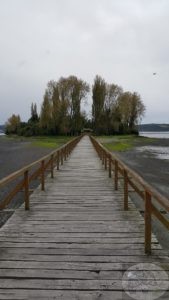
Wood walkway across the bay to the church
UNESCO churches and stormy weather
The following morning found me back in the car again, on the way to Isla Grande de Chiloe, the continent’s fifth largest island, approximately 110 kilometers south of Puerto Varas. There is no bridge, so I ended up on a ferry that could carry about 10 vehicles. The crossing was a short one, but cold. The weather had turned, and it was cloudy, with the occasional spattering of rain. I had been told that the island was a wonderful place to explore, and so I went on my way. As on the previous day, instead of staying to the main highway, I veered off onto unpaved roads as soon as possible – perhaps not always the wisest choice, and there were occasions when I thought I had made the wrong decision, but the exploration aspect of the trip was definitely worth it. There is a route called the churches route, one that takes visitors and pilgrims to very distinct and interesting Jesuit churches, all with an important story, most of them built of wood. I did not stop in at many of them, as there are simply too many to visit in one day. One of the churches, Iglesia Caguach, would have required several other ferry trips, and would have taken most of the day as it is situated on another island. Most of the churches are found along the east coast of the island, and quite a number of them are UNESCO heritage sites.

Church at the end of the wood walk on a small island in the bay.
Charming towns on South America’s 5th largest island
As with the trip around the lake the previous day, the countryside varied greatly along the coast, yet it was unfortunate that the rain would not let up for more than half an hour at a time; it kept me car-bound for most of the day. Even so, I made my way up hills, from the tops of which I had great views of the ocean and towns below. I passed through several quaint villages, and also through some areas not so much different from northern Ontario – sparsely populated, with housing that appeared barely standard.

Plaza de Armas, Castro, Chile
I reached the city of Castro and spent a short time in the Park Plaza de Armas de Castro, enjoying a cup of coffee, and taking in city life. The Iglesia San Fransisco stands at the northern end of the plaza, and with its twin towers of 42 meters, was the highest monument in the city; unfortunately it is now eclipsed by a highrise apartment building. The present structure dates from 1910, although originally it was built in 1711 by Jesuits. The church was declared a National Historic Landmark and a World Heritage Site by UNESCO. As the temperature started to decline, it was time for me to start my return journey.

A road…. on shore while the water is at ebb; but what about at flood…?
A rocky shore as main road
Having come along the east coast of the island, I opted for exploring the west coast as soon as a road taking me in that direction appeared. Winding my way along the country roads I suddenly came upon the coast, and continued to follow the map on my phone, which clearly showed a route that would take me back to the port and the ferry. Coming across another small rise I was suddenly greeted by a seawall, and I followed the directions to the right. A fishing boat lay off the coast, while only a short distance ahead I could see a similar vessel much closer to shore, seemingly beached, and I wondered where the road was taking me. There was no turn to the right, and to the left was the open water, in front of me, a gravel-covered shore that seemed to serve as a road during low tide. I didn’t want to turn around, and according to my map, this was actually the road – I was a bit concerned whether or not the tide was in, out, or on its way back in, but decided to keep moving ahead, calculating that the water was not likely to rise that quickly, and if it did, I would maybe be able to outrun it by veering off to the right and plowing into someone’s front yard. I followed the shoreline for a few kilometers, and soon found the turn I needed to take to the right to start making my way eastward again. A large wooden church rose up on the hillside in front of me. I circled around to the back of the building and found the eastward bound track once again. The countryside through which I passed was much the same as that from earlier in the day, and I could only wish that the weather would have been nicer. Then again, it will be an excuse for me to visit the island again in the summer time and spend much more time exploring and discovering the beauty it contains.

Access to Chiloe, ferries that carry few vehicles.
A country ripe for exploring
The crossing by ferry back to the mainland was uneventful, although the hot coffee on board certainly helped to warm me up. As I made my way north again toward Puerto Varas, the weather took a turn for the better, and by the time I arrived near the town, the sun was out, although the temperature was still low. I took a few more side roads as I approached the town, and was once again made aware of the beauty of the surrounding countryside and how much there is to explore and enjoy in this virtually undiscovered place.
